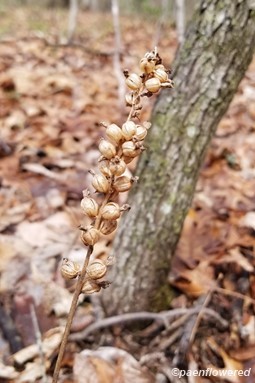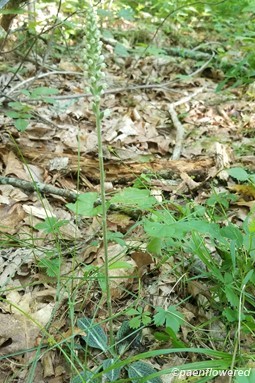Goodyera pubescens
Overwintering plant whose leaves marked with distinctive silvery veins
Goodyera pubescens downy rattlesnake-plantain
This plant is not a true plantain, though it superficially resembles the common plantain, a common lawn weed. It is actually a member of the orchid family. It is supposed to be the most common native orchid in the state, but rare enough that it is not often seen. It has a range that covers most of the eastern United States, but seems most common in the north and in the southern mountains.
Its name comes from the checkered pattern on the dark blue-green basal leaves from the white veins and cross veins. This makes the leaves somewhat resemble the skin of a snake and makes them easy to spot in winter. All parts of the plant are covered with fine hairs. The tiny ¼ inch globular flowers are on a spike-like raceme on a leafless stalk that vaguely resembles a rattle. Each flower has an upper hood made from a sepal and two upper petals and a cupped lower lip petal. The flower spike seems to develop slowly and is often seen with only a few of the flowers open.
The rattlesnake plantain grows in oak woods in well-drained soil. It can spread by horizontal stems called stolons. It can grow to a height of 18 inches, though often it is smaller. Sometimes it can grow on mossy rocks. Because of its distinctive appearance, some people collect it for terrariums, but this is discouraged because the plant is not common. The leaves remain alive during the winter and the plant can live several years.
Habitat & Range
Grows in dry to moist deciduous and coniferous forests.
Present in most counties of the state.
Range: Found in most of the eastern US.
| EMP: | FACU |
|---|---|
| NCNE: | FACU |
Phenology
Flowers June through August.
Plant Codes
S-rank: No rank
G-rank: G5 (Secure)













Comments
Have you spotted this plant in your area? We'd love to hear about your experience! Share your comments or questions about the plant below. Comments are moderated before posting.